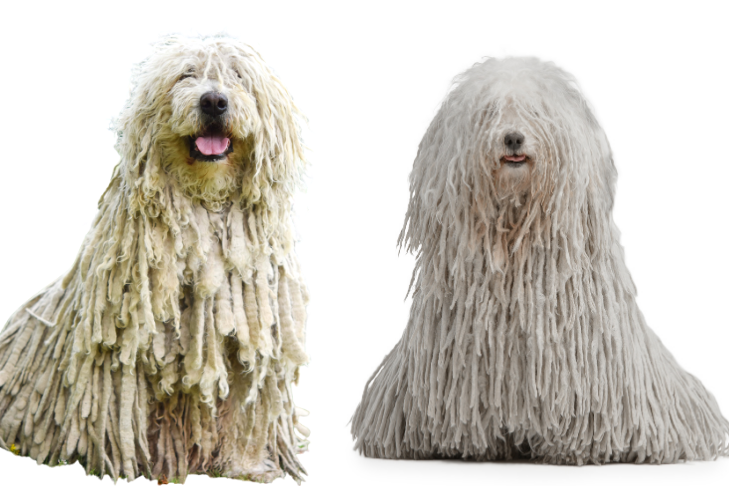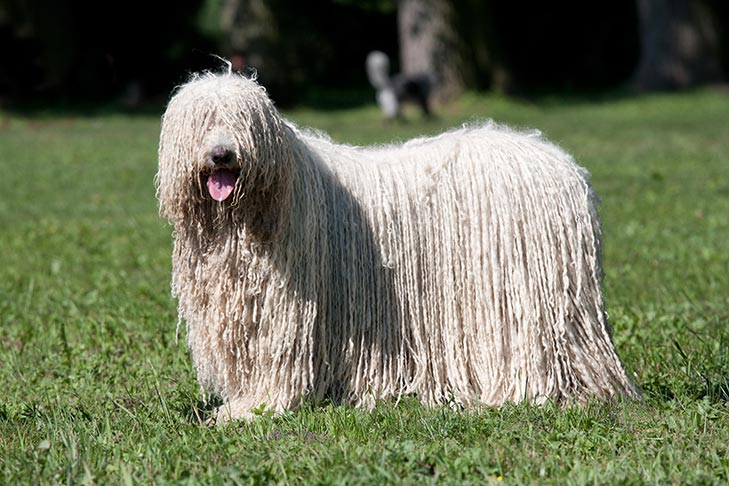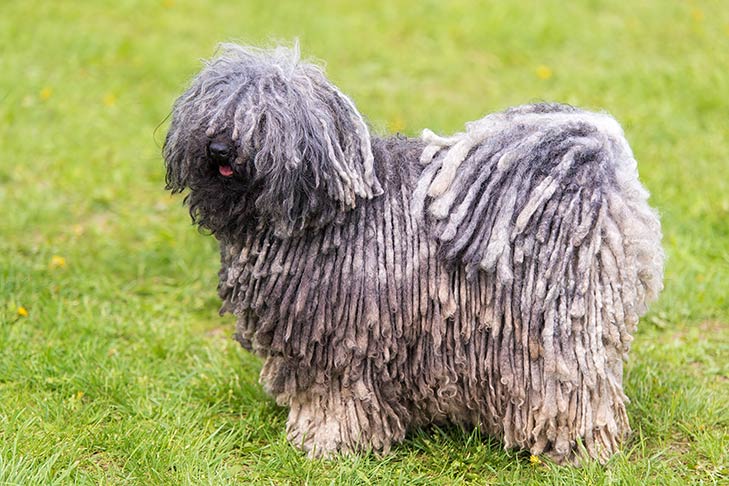
Have you ever seen a Puli, that adorable shaggy dog with the corded coat? There’s no mistaking the breed. That is until you see the Komondor! These equally corded dogs are not just giant Pulik (the Hungarian plural of Puli), they are a breed all their own. Although both the Puli and Komondor share Hungarian history, there are a lot of distinctions between them. Read on to learn how to tell the difference between these two gorgeous and unusual looking dogs.
Confusing Corded Coats
Anna Quiqley, past president of the Puli Club of America and current president of the Komondor Club of America, is an approved AKC judge of both breeds. She says people sometimes confuse the Puli for a small Komondor. But once they get to know the breeds, they realize the only similarity is the corded coat and the fact that both breeds are Hungarian flock dogs. According to Quiqley, “The Komondor is the flock guardian, and as an adult is very aloof. The Puli is a much smaller dog bred to herd the sheep. The Puli needs a job and is very bonded to his owner.”
AKC judge John Landis is a past president of the Komondor Club of America and the current chair of the Judges Education Committee. He agrees that the corded coats are the main reason people confuse the two breeds, but that’s where the similarity ends. “Komondors are livestock guardians. They are loyal to their masters but very independent. They are always white, much larger than Pulik, have different body and head proportions, don’t have curly tails, and are much harder to train.”
- Komondor
- Puli
Hungarian Dogs With Different Purposes
The Puli is an ancient sheepdog from Hungary. They were brought to Hungary by the Magyars over one thousand years ago to work as herding dogs. Quiqley explains the importance of the breed’s agility in the field. “The terrain is very rough, not to mention that the breed would often be required to jump on the back of the livestock to do their job.”
The Komondor originated in Tibet as dogs of the Cumans. However, Landis explains, “In the thirteenth century, the Cumans and their dogs were forced to move by the Mongol expansion to the west and located in the area now called Hungary. They have remained there since and were used for their original purpose as a livestock guardian.”
Both breeds were almost lost during the Second World War. According to Quigley, although shepherds worked for generations to preserve the Puli’s greatest attributes of agility and willingness to work, the war took its toll. “As with many Hungarian breeds, World War II was not good to the Puli. Many of them were killed by bombs and bullets, devastating many lines. It took years to bring them back.”
Differing Temperaments
The different job in each breed’s heritage has led to different personalities. Landis says because Pulik are herding dogs, they are far more willing to please. “The Komondor is much more laid back while the Puli is more active and always ready to herd something.”
Being a guard dog, the Komondor will try to protect the territory they oversee. Landis sees that guarding temperament as one of the true characteristics of the breed. “They are extremely loyal, loving, and protective. They are trainable, but it takes some effort as they were bred to be independent.”
Quigley gives people some important advice about the herding Puli. “You have to be willing to have two things in your toolbox if you want to own a Puli: a sense of humor and an understanding that this is a breed that needs a job.”
She says the Puli is a good, dependable herding dog that will herd anything. But they also excel in Obedience, Rally, Agility, and plenty of other performance events. They want to be with their family and need to learn what is expected of them while they’re still young. And Quigley warns that along with being smart, they bark a lot.
- Komondor
- Puli
Caring for Those Cords
The definitive cords in both breeds are a natural part of how the coat grows. The cording process in the Puli starts between ten months of age and a year old. Quiqley says a lot of people become overwhelmed at that point and cut them off. However, “Once the cords are formed and the adult coat is growing, it is a very easy coat to maintain. Although people will sometimes complain about the amount of stuff coming into the house in the coat. Even critters.”
Landis has a similar warning, saying it can be challenging to keep the Komondor clean as their coat mops up a lot of dirt. He explains that the Komondor puppy has a somewhat curly, wavy coat. Then, at about six months, the adult coat starts to come in as a coarse, curly coat. This coat mats quite easily and requires separation. “This matting continues as the hair grows and must be separated at the skin. The size of the mat determines the size of the cord. The coat is not shed, so the hair at the end of the cord is the hair the puppy had at around six months of age.”
- Komondor puppy
- Puli puppy
Not for Everybody
Landis, having trained and lived with both breeds, warns that Komondors require socialization and training and are not for everyone. “They are guard dogs and require a master who they love and adore.”
Pulik are considerably easier to train but are a bit more vocal than the substantially larger Komondor. They have a personality all their own. According to Quiqley, Puli owners will say, “It is not a dog, it is a Puli.”
Whether you see a corded companion in your future or you simply spy one at the dog park, now you’ll know what kind of personality to expect based on whether you’re looking at a Puli or a Komondor.









